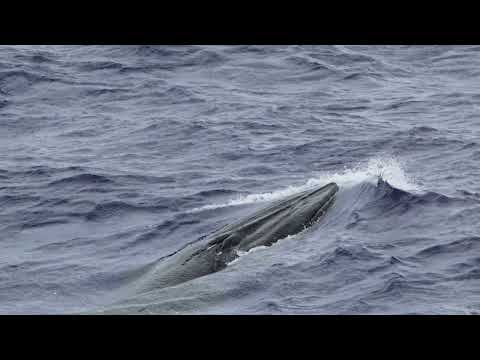Whales are known for their noise, from humpback whale songs to the clicks and whistles of orcas and other toothed cetaceans. A naive and untrained Bryde’s whale makes an even weirder noise called “Biotwang.” This shrill sound that uses low and high pings sounds almost electronic or mechanical, unlike the more melodic songs made by other baleen whales.
Now, this amazing sound has been recorded and is part of a new archive that could help other scientists learn the voices of whales from eight different species. The findings are described in a study published on September 18 in the journal Frontiers in Marine Science.
[Related: We finally know how baleen whales make noise.]
What is Biotwang?
Bryde’s whales – named broodus-found in the central and western North Pacific. They are less well known than other baleen whales such as minke whales or right whales.
“Bryde’s whales are different from other baleen whales in that we think they can feed year-round, migrate between mid-latitudes, and follow their food throughout the ocean,” co-author Dr. of NOAA research Ann Allen says. Normal Science.
Their more complex ways of moving around the ocean make it difficult for scientists to find them. The team recorded many of these sounds in 2014 using independent sound recorders taken from the Mariana Islands near Guam.

Biotwang is produced by Bryde’s whales in the Pacific Ocean. This photo of a Byrde’s whale was seen during NOAA’s cetacean survey in the Mariana Archipelago in 2015. The whale was photographed over the Mariana Trench in October 2014 during the Oregon State University Seaglider study. CASE STUDY: Nieukirk et al. 2016/ NOAA Fisheries/ Andrea R. Bendlin (NMFS MMPA-ESA Permit #15240)
“We’ve found it consistently in the western North Pacific, which means that this line may be different from a population that’s only found in this region,” says Allen. “That’s important because the whale calls go very far under the water, and it allows us to monitor the whales all year round without the need for a human to watch them, but we can only do that if we know if they are what kind makes that sound.”
Even more difficult than the whales themselves is the decline in what biotwang is used for. The team heard Biotwangs from individual whales, small mixed groups, and mothers with calves during migration.
“It’s possible they’re using the Biotwang as a mobile phone, a sort of ‘Marco Polo’ of the sea,” says Allen. But we need more information before we can say for sure.
Food, boings, and lots of data
The NOAA team had long-term records of parts of the Pacific Ocean back in 2005 and were able to point out that Bryde’s whales are the source of this unusual sound. They then worked with a team of Google researchers to analyze it. Data scientists used Biotwang’s recordings to program their own multi-scale AI model to analyze the massive underwater sound from the Pacific Ocean. With so much noise from ships, plants, animals and the movement of the ocean itself, it can be difficult to understand the sounds beneath the sea.
“Biotwang has this low-frequency component followed by this high-frequency component,” co-author and Google data scientist Lauren Harrell says. Normal Science. “I think it really sounds like the original ‘ping’ on the Starship Enterprise from takeoff Star Trek.”
In addition to telling Bryde’s whales apart from other sounds based on their behavior, this model can be used to predict whale migration and identify other sounds made by minke whales, which are often called “minke boing.” These sounds were first detected by submarines off the coast of California and Hawai’i in the 1950s and described as a “bell-like ringtone.”
[Related: We can protect whales from ship strikes by translating their songs.]
Harrell says: “Minke boing also has a similar history to Biotwang, as this strange sound that scientists later discovered came from a certain type of whale. “We were able to do some minke labels for example and we found that all the minke were boing because we went back though all these samples.”
The method that Harrell and his team worked on now allows researchers to understand the sounds of up to eight species of whales in a single recording. They can then use it to track sounds to where and when they occur in different parts of the world to inform better conservation practices.
“Having a model that can go through these long-term resources properly and identify and isolate where some of these species may be, can also be time-consuming and time-consuming to say help study these species,” Harrell said.
#hum #whale #version #Marco #Polo